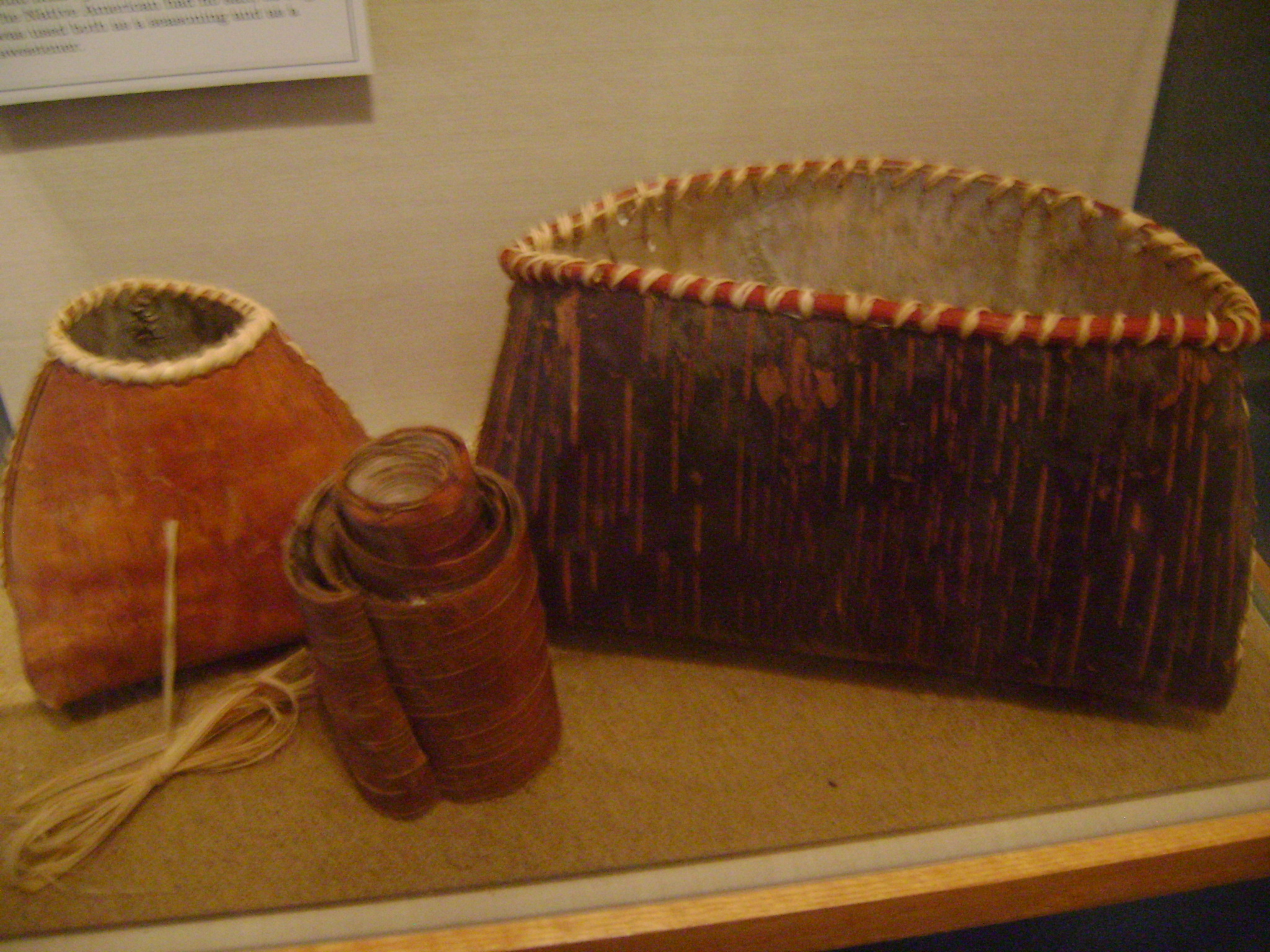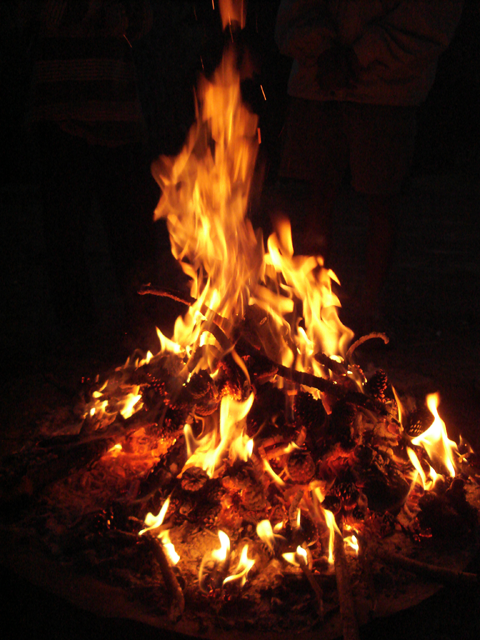|
Wiigwaasi-makak
A wiigwaasi-makak (plural: ''wiigwaasi-makakoon''), meaning "birch-bark box" in the Anishinaabe language, is a box made of panels of birchbark sewn together with watap. The construction of ''makakoon'' from birchbark was an essential element in the culture of the Anishinaabe people and other members of the Native Americans and First Nations of the Upper Great Lakes, particularly in the regions surrounding Lake Superior. Birchbark ''makakoon'' continue to be crafted to this day as heritage heirlooms and for the tourist trade. Lake Superior-area geology is short in supplies of clay, making pottery scarce for the people who lived there. However, the paper birch grows in profusion in this area, and sheets and panels of its strong, papery bark can be cut and carved from a tree for use. Birchbark boxes played a key role in creating durable packages and utensils for storage and everyday use. Skilled harvesting of the bark, done at the proper season of the year, does not fatally i ... [...More Info...] [...Related Items...] OR: [Wikipedia] [Google] [Baidu] |
Wiigwaasabak
''Wiigwaasabak'' (in Anishinaabe syllabics: , plural: ''wiigwaasabakoon'' ) are birch bark scrolls, on which the Ojibwa (Anishinaabe) people of North America wrote complex geometrical patterns and shapes, also known as a "written language." When used specifically for Midewiwin ceremonial use, these scrolls are called ''mide-wiigwaas'' (in syllabics: ). These enabled the memorization of complex ideas, and passing along history and stories to succeeding generations. Several such scrolls are in museums, including one on display at the Smithsonian Museum in Washington, DC. In addition to birchbark, copper, and slate may have also been used, along with hides, pottery, and other artifacts. Some archaeologists are presently trying to determine the exact origins, dates, and locations of their use. Many scrolls were hidden away in caves and man-made pits. Construct The bark of the paper birch tree provides an excellent writing material. Usually, a stylus of either bone, metal or ... [...More Info...] [...Related Items...] OR: [Wikipedia] [Google] [Baidu] |
Watap
Watap, watape, wattap, or wadab ( or ) is the thread and cordage used by the Native Americans and First Nations peoples of Canada to sew together sheets and panels of birchbark. The word itself comes from the Algonquian language family, but watap cordage was used and sewn by all of the people who lived where the paper birch tree grows. The cordage was usually manufactured from the roots of various species of conifers, such as the white spruce, black spruce, or Northern whitecedar, but could originate from a variety of species that sprouted root fibers with sufficient tensile strength for the required purpose. In a typical manufacturing process, the roots would be debarked, subjected to a lengthy soaking process, and then steamed or boiled to render them pliable for sewing. The roots could be left whole and used as cords, or divided into smaller fibers for twine.Willow, Anna J. Winter 2010. Cultivating Common Ground: Cultural Revitalization in Anishinaabe and Anthropological D ... [...More Info...] [...Related Items...] OR: [Wikipedia] [Google] [Baidu] |
Betula Papyrifera
''Betula papyrifera'' (paper birch, also known as (American) white birch and canoe birch) is a short-lived species of birch native to northern North America. Paper birch is named for the tree's thin white bark, which often peels in paper like layers from the trunk. Paper birch is often one of the first species to colonize a burned area within the northern latitudes, and is an important species for moose browsing. The wood is often used for pulpwood and firewood. Description It is a medium-sized deciduous tree typically reaching tall, and exceptionally to with a trunk up to in diameter. Within forests, it often grows with a single trunk but when grown as a landscape tree it may develop multiple trunks or branch close to the ground. Paper birch is a typically short-lived species. It handles heat and humidity poorly and may live only 30 years in zones six and up, while trees in colder-climate regions can grow for more than 100 years. ''B. papyrifera'' will grow in many so ... [...More Info...] [...Related Items...] OR: [Wikipedia] [Google] [Baidu] |
American Indian Relics
American(s) may refer to: * American, something of, from, or related to the United States of America, commonly known as the "United States" or "America" ** Americans, citizens and nationals of the United States of America ** American ancestry, people who self-identify their ancestry as "American" ** American English, the set of varieties of the English language native to the United States ** Native Americans in the United States, indigenous peoples of the United States * American, something of, from, or related to the Americas, also known as "America" ** Indigenous peoples of the Americas * American (word), for analysis and history of the meanings in various contexts Organizations * American Airlines, U.S.-based airline headquartered in Fort Worth, Texas * American Athletic Conference, an American college athletic conference * American Recordings (record label), a record label previously known as Def American * American University, in Washington, D.C. Sports teams Soccer * B ... [...More Info...] [...Related Items...] OR: [Wikipedia] [Google] [Baidu] |
Medicine Bag
A medicine bag is usually a small pouch, worn by some Indigenous peoples of the Americas, that contains sacred items. A personal medicine bag may contain objects that symbolize personal well-being and tribal identity. Traditionally, medicine bags are worn under the clothing. Their contents are private, and often of a personal and religious nature. See also * Medicine man * Midewiwin * Medicine wheel To some indigenous peoples of North America, the medicine wheel is a metaphor for a variety of spiritual concepts. A medicine wheel may also be a stone monument that illustrates this metaphor. Historically, most medicine wheels follow the basic ... References Bags Native American religion Religious objects Traditional medicine Spiritualism Amulets Talismans {{NorthAm-native-stub ... [...More Info...] [...Related Items...] OR: [Wikipedia] [Google] [Baidu] |
Quillwork
Quillwork is a form of textile embellishment traditionally practiced by Indigenous peoples of North America that employs the quills of porcupines as an aesthetic element. Quills from bird feathers were also occasionally used in quillwork. History Porcupine quillwork is an art form unique to North America. Before the introduction of glass beads, quillwork was a major decorative element used by the peoples who resided in the porcupine's natural habitat,Gillow and Sentance 223 which included indigenous peoples of the Subarctic, Northeastern Woodlands, and Northern Plains. The use of quills in designs spans from Maine to Alaska.Orchard Quillworking tools were discovered in Alberta, Canada and date back to the 6th century CE. Cheyenne oral history, as told by Picking Bones Woman to George Bird Grinnell, says quilling came to their tribe from a man who married a woman, who hid her true identity as a buffalo. His son was also a buffalo. The man visited his wife and son in their buffalo ... [...More Info...] [...Related Items...] OR: [Wikipedia] [Google] [Baidu] |
Porcupine
Porcupines are large rodents with coats of sharp spines, or quills, that protect them against predation. The term covers two families of animals: the Old World porcupines of family Hystricidae, and the New World porcupines of family, Erethizontidae. Both families belong to the infraorder Hystricognathi within the profoundly diverse order Rodentia and display superficially similar coats of rigid or semi-rigid quills, which are modified hairs composed of keratin. Despite this, the two groups are distinct from one another and are not closely related to each other within the Hystricognathi. The largest species of porcupine is the third-largest living rodent in the world, after the capybara and beaver. The Old World porcupines (Hystricidae) live in Italy, Asia (western and southern), and most of Africa. They are large, terrestrial, and strictly nocturnal. The New World porcupines (Erethizontidae) are indigenous to North America and northern South America. They live in wooded area ... [...More Info...] [...Related Items...] OR: [Wikipedia] [Google] [Baidu] |
Spine (zoology)
In a zoological context, spines are hard, needle-like anatomical structures found in both vertebrate and invertebrate species. The spines of most spiny mammals are modified hairs, with a spongy center covered in a thick, hard layer of keratin and a sharp, sometimes barbed tip. Occurrence Mammals Spines in mammals include the prickles of hedgehogs and among rodents, the quills of both New World and Old World porcupines as well as the prickly fur of spiny mice, spiny pocket mice and spiny rats. They are also found on afrotherian tenrecs, marsupial spiny bandicoots and on echidnas, of the monotremes. An ancient synapsid, '' Dimetrodon'', had extremely long spines on its backbone that were joined together with a web of skin that formed a sail-like structure. Many mammalian species, like cats and fossas, also have penile spines. The Mesozoic eutriconodont mammal ''Spinolestes'' already displayed spines similar to those of modern spiny mice. Fish Spines are found in the rays o ... [...More Info...] [...Related Items...] OR: [Wikipedia] [Google] [Baidu] |
Combustion
Combustion, or burning, is a high-temperature exothermic redox chemical reaction between a fuel (the reductant) and an oxidant, usually atmospheric oxygen, that produces oxidized, often gaseous products, in a mixture termed as smoke. Combustion does not always result in fire, because a flame is only visible when substances undergoing combustion vaporize, but when it does, a flame is a characteristic indicator of the reaction. While the activation energy must be overcome to initiate combustion (e.g., using a lit match to light a fire), the heat from a flame may provide enough energy to make the reaction self-sustaining. Combustion is often a complicated sequence of elementary radical reactions. Solid fuels, such as wood and coal, first undergo endothermic pyrolysis to produce gaseous fuels whose combustion then supplies the heat required to produce more of them. Combustion is often hot enough that incandescent light in the form of either glowing or a flame is produced. A ... [...More Info...] [...Related Items...] OR: [Wikipedia] [Google] [Baidu] |
Boiling Point
The boiling point of a substance is the temperature at which the vapor pressure of a liquid equals the pressure surrounding the liquid and the liquid changes into a vapor. The boiling point of a liquid varies depending upon the surrounding environmental pressure. A liquid in a partial vacuum has a lower boiling point than when that liquid is at atmospheric pressure. A liquid at low pressure has a lower boiling point than when that liquid is at atmospheric pressure. Because of this, water boils at under standard pressure at sea level, but at at altitude. For a given pressure, different liquids will boiling, boil at different temperatures. The normal boiling point (also called the atmospheric boiling point or the atmospheric pressure boiling point) of a liquid is the special case in which the vapor pressure of the liquid equals the defined atmospheric pressure at sea level, one Atmosphere (unit), atmosphere. At that temperature, the vapor pressure of the liquid becomes suffici ... [...More Info...] [...Related Items...] OR: [Wikipedia] [Google] [Baidu] |
Campfire
A campfire is a fire at a campsite that provides light and warmth, and heat for cooking. It can also serve as a beacon, and an insect and predator deterrent. Established campgrounds often provide a stone or steel fire ring for safety. Campfires are a popular feature of camping. At summer camps, the word campfire often refers to an event (ceremony, get together, etc.) at which there is a fire. Some camps refer to the fire itself as a campfire. History First campfire A new analysis of burned antelope bones from caves in Swartkrans, South Africa, confirms that '' Australopithecus robustus'' and/or '' Homo erectus'' built campfires roughly 1.6 million years ago. Nearby evidence within Wonderwerk Cave, at the edge of the Kalahari Desert, has been called the oldest known controlled fire. Microscopic analysis of plant ash and charred bone fragments suggests that materials in the cave were not heated above about . This is consistent with preliminary findings that the fires burned gras ... [...More Info...] [...Related Items...] OR: [Wikipedia] [Google] [Baidu] |

.jpg)




